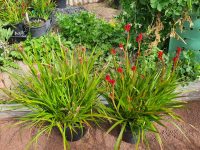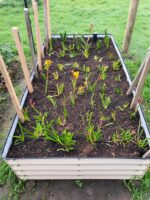Spring has sprung and the weather is getting warmer. With this in mind, I thought it would be good to share some of my water efficient garden ideas to help keep plants happy, healthy and productive. With water resources under ever increasing pressure, using water well and wisely should be on everyone’s to do list! Also, it is not just about saving water, it is also about making sure that you deliver water in a way that stops your plants ever being under water stress.
Plants that have the right amount of water supplied when they need it will show it, with good strong growth, flowering and sometimes fruiting as well. When we don’t get it right, water stress can lead to problems that can get blamed on other causes such as pests or disease…..it is wasteful and can also be damaging to the plant and the environment generally when a gardener sees a symptom and jumps to the conclusion that pesticides or fungicide are necessary to deal with it, when sometimes it is as simple as a lack of water, uneven or irregular watering that is to blame. Blossom end rot in tomatoes and capsicums and aborted flower buds in kangaroo paws are just two examples of misdiagnosed problems that are simply prevented by improving water use in the garden. The picture below is of two kangaroo paws, the one on the left dried out while it was budding up and as you can see, the flowers have suffered compared to the unstressed one on the right-
So, how to remedy such a seemingly simple problem? A lack of water can have various causes and remedies:
- When you water your garden, get out a spade and dig down when you think you have properly watered your soil because it is wise to check how far down it is penetrating into the soil. You want to be sure that you are wetting more than just the surface layer, otherwise your watering will be encouraging the roots to stay in that very top layer. Get a good idea of how long it takes for the water to penetrate down at least 30cm as that will ‘train’ the roots to go deeper to find water that has accumulated in your subsoil. Longer periods spent watering but less often will help your plants adapt to finding their own water supply rather than relying on you.
- Encouraging root growth downwards rather than on the soil surface means the roots are more protected when scorching temperatures arrive….a number of plants such as boronias seem to greatly benefit from a cooler root run. Again, on a hot day, dig a hole 30 com deep and feel how much cooler the subsoil is than the topsoil.
- Create a cooler root run and less evaporation with an appropriate mulch. A mulch is defined as a layer on top of the soil that provides an insulating barrier between the air and topsoil. When thinking mulches it is all about large particle size, light colour and a depth of no more than 5cm. Large chunky mulches trap more air to better insulate your soil against moisture loss through evaporation as they keep your soil coooler, particularly in summer. Light coloured mulches such as straw are more effective at repelling heat than darker colours, this is particularly important if you are using inorganic mulches such as gravel which are often dark in colour (think about walking bare foot across a tar-sealed road on a hot summer’s day). Also, a depth of 5cm gives maximum insulation whilst also allowing any water that falls on it to have a better chance of reaching the soil underneath, and also be aware that plant based mulches such as lucerne hay can soak up water, so be sure the moisture is penetrating the mulch and getting down into your soil. Be sure to keep mulch away from stems or trunks of your plants though,
- Rockeries can be a great way to create a cool root run in summer as the soil adjacent to fairly large rocks will be cooler in summer, reducing evaporation but warming the soil in winter to promote root growth when water loss is not usually a great concern.
- Windy weather can cause water stress as plants may lose more moisture through their leaves through a much faster evaporation rate caused by the turbulent windy air across the leaf surfaces. They can sometimes lose water faster than they can take it in through their roots, causing severe water stress or even plant death. Be alert to which plants may need extra watering in windy weather, or if they are in pots they can be moved to a more sheltered spot. Using extra tough plants to create wind breaks can provide a long term solution. Plants like kangaroo paws can alert you via curling flower stems, or wilting growth
- Old potting mix or garden soil can become water repelling (the technical term is hydrophobic). If you are finding it hard to get water into your pot plants the perfect solution is to dunk the whole pot in a bucket of water and leave it there until there are no more air bubbles emerging from the water. The use of horticultural wetting agents will help as will the addition of organic matter in the form of worm castings or mature compost will greatly improve the soil’s ‘wettability’ improves soil structure which helps soil retain water
- Build your soil’s water holding capacity with ‘spongy’ materials such as compost, coconut (coir) fibre or worm castings. I have been experimenting lately with turning all of the bushfire fuel in the bushland areas near my house into biochar (biological charcoal in other words). Not only does this reduce the bushfire hazard but it stores a very long-lived form of carbon (charcoal) in your soil. All of these organic materials also helps build your soil’s nutrient holding capacity as well.
- Get science on your side and consider installing wicking beds, which have a reservoir of water underground which rises through the soil via wicking (capillary) action. This results in roots going downwards to reach the water, and pretty much eliminates evaporation from the soil surface, thus saving huge amounts of water over the warmer months. The other great advantage of wicking beds is that, provided you keep the reservoir topped up, your plants never get water stressed because they always have a supply of water from beneath and this is particularly important for fast growing food plants. Read more about the science of wicking beds here>>>
I have put in some WaterUps wicking beds for my kangaroo paw breeding stock, as I am limited to farm dams and tanks on my property, and want to achieve the best growth possible because once I pollinate the flowers, even a day of water stress can abort the developing seed pods. I will also be growing some the regular way in raised beds without the wicking for comparison, so will be able to demonstrate the difference in future newsletters (plus show off more beautiful kangaroo paw flowering!)


